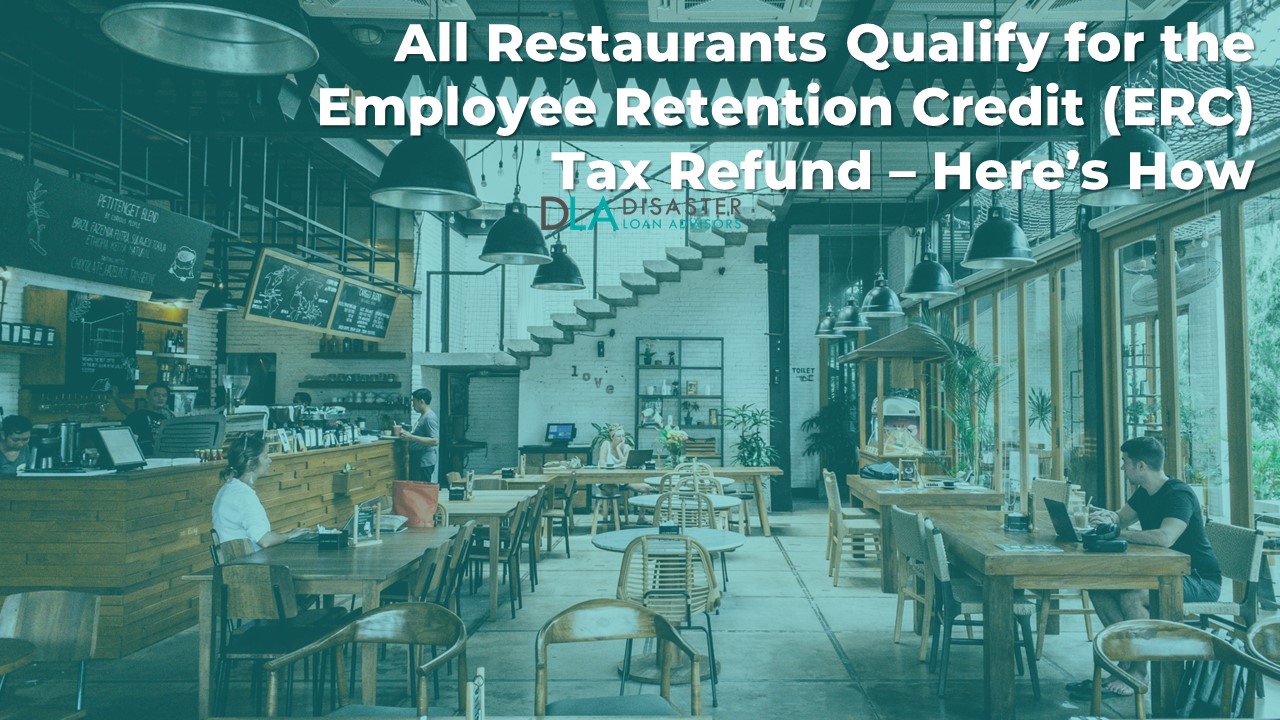
These unprecedented times have come with much hardship, especially for the restaurant industry, where employers suddenly found themselves responsible for their employees’ incomes.
The good news is that the Employee Retention Credit (ERC) Tax Refund can help to provide relief for your employees who have been impacted by COVID. This refund can help offset the negative impacts of COVID on your restaurant and recoup some of the associated costs.
Even as restaurants begin to recover from the economic challenges caused by the COVID-19 pandemic, they are still eligible for the Employee Retention Credit (ERC) Tax Refund, which remains open for claiming in 2022, 2023, and 2024. It is based on certain qualifying criteria of quarters in 2020 and 2021, and then calculating a percentage of prior payroll your company paid to employees during that period of time in 2020 and 2021.
Your restaurant DID NOT have to be fully shutdown to qualify. It could have been only partially shut down. If your Accounting, Tax, or Financial Professional told you that your restaurant does not qualify, they are completely wrong and do not fully understand the comprehensive current guidelines for the ERTC.
According to the Internal Revenue Service IRS ERC rules, one important way to qualify and have eligibility for this tax credit can be determined by the restrictions imposed on the restaurant’s location by either state or local governmental authority during the pandemic. From the government mandated start date of restaurant capacity restrictions to the end date when those same restrictions were fully lifted, your restaurant qualifies for the ERC Credit and tax refund.
Keep reading this comprehensive Employee Retention Credit (ERC) Tax Refund Quick Start Guide for Restaurants to determine if your restaurant is eligible for this tax refund. We’ll cover the criteria for eligibility, how to apply, and helpful resources. By the end of this guide, you’ll have a comprehensive understanding of the ERC for restaurants and how to maximize its tax benefit.
Key ERC Credit Takeaways You Will Learn:
- ERC for Restaurants: Learn the specifics of Employee Retention Credit for restaurants.
- Calculating ERC: Discover how to calculate Employee Retention Credit for your restaurant.
- Strategic Usage: Uncover how restaurant owners can leverage the Employee Retention Credit.
- Maximization Tips: Absorb six essential tips to maximize ERC benefits for your restaurant.
- Avoiding Claim Mistakes: Understand the common mistakes to avoid during the ERC claim process.
See Important 2024 Employee Retention Tax Credit Deadline Information at the Bottom of This Article.
What is the Employee Retention Credit For Restaurant Owners?
The Employee Retention Credit (ERC) allows qualifying restaurants, bars, cafes, and other food service businesses to receive money back on gross wages and some employment taxes by claiming a refundable tax credit equal to 50% of qualified gross wages salaries paid between March 12, 2020, and December 31, 2020.
For 2021, a refundable tax credit equal to 70% of qualified gross wages salaries paid between January 1, 2021 and September 30, 2021 for businesses already in existence prior to February 15, 2020. Restaurants started or purchased after Feb. 15th, 2020 (also known as a Recovery Start-up in IRS ERC terms) can claim employee wages through December 31, 2021.It was created as part of the Coronavirus Aid, Relief, and Economic Security (CARES) Act to assist small and midsize businesses like restaurants and hotels in continuing payroll expenses throughout the epidemic. The goal was to encourage employers staff retention and avert layoffs.
Many amendments and changes have been made to the ERC since 2020. According to the Infrastructure Investment and Jobs Act, it now only applies to wages paid before October 1, 2021 (with the exception of recovery startup businesses working towards recovery, which have until January 1, 2022).

How Does the Employee Retention Credit Work For Restaurants?
Being that the eligibility requirements and amount of credits awarded have changed multiple times since the ERC program was launched, it can be tricky for restaurant owners to figure out if they qualify and how much they are entitled to.
Pro Tip: The key to receiving the maximum benefit from this tax credit is understanding how to safely qualify the eligible quarters, and then which employees, wages, and payments qualify for the credit.
To claim the Employee Retention Tax Credit, employers first needed to determine their eligibility and then estimate the credit amount for each pay period. They would then deduct this amount from their payroll tax deposit and report the credit on IRS Form 941-X. The 941-X is amending the original Employer’s Quarterly Federal Tax Return (Form 941) payroll, which is typically due within 30 days of the end of the quarter.
If the credit exceeds the tax deposit, the employer could request an advance payment using Form 7200 (no longer used for ERC) and receive a refund for the excess amount. However, since the program has ended, the process for claiming credit has changed.
Although the Employee Retention Tax Credit program has ended, restaurants may still be able to claim the credit for eligible quarters within three years of the program’s sunset date. This includes employers who received a Paycheck Protection Program (PPP) loan.
The process for claiming the credit may be different for quarters that ended on or after September 30, 2021. Employers will need to confirm the details of their specific situation.
In order to receive the tax credit, restaurant owners must document and prove that their business was negatively affected by the pandemic, either through revenue or capacity restrictions. They must also prove that they paid their employees during these times. Owners must keep accurate records of all employee payrolls, including pay periods and qualified wages paid.
Is My Restaurant Eligible for the Refundable Tax Credit? ERC Eligibility Requirements For Restaurants
Yes! Restaurants are eligible to claim the employee retention credit in only one of two ways.
The first way a restaurant can qualify is if it experienced a full or partial shutdown due to COVID-19 government regulations or any other government-mandated shutdown of operations during specific periods in 2020 or 2021 due to the pandemic.
The second way a restaurant can qualify for the ERC is if it has experienced a significant decline in gross receipts compared to one of two prior years (2019 versus 2020 or 2021). A decline in gross receipts is significant when the decline is more than 50% in 2020 as compared to the same quarter in 2019, or 20% in 2021 compared to the same quarter in 2019. In clear terms, you have to compare the same quarters of 2020 and 2021 with 2019.
For example, if a restaurant had gross receipts of $100,000 in the 2nd quarter of 2019 and $50,000 in the same quarter in 2020, it would meet the criteria for a significant decline in gross receipts. Similarly, for 2021, if your restaurant had gross receipts of $80,000 in the same quarter, then it would meet the criteria for a significant decline.
The following are some examples of gross receipts:
- Total sales and revenue received (before any deductions).
- This fund includes proceeds from investments and grants.
- The adjusted basis in certain property used in a trade or business, such as capital assets sold, is not reduced by the taxpayer.
- This includes any money made from investments.
- Royalties and annuities.
- Interest.
- Rents.
- Dividends.
If you are a restaurant owner and paid wages to less than 100 employees in any quarter in 2020 (500 employees or less in 2021), those payroll gross wage numbers and salaries will be counted towards the ERC tax credit – regardless of whether they were full-time or part-time.
To clear your mind for the full-time or partial closure of your business due to COVID-19, the Internal Revenue Service (IRS) provides the conditions to help restaurants qualify for the Employee Retention Credit.
They are as follows:
1. Social Distancing Through Capacity Restrictions at Your Restaurant or Hotel’s Location
If you were forced to reduce your restaurant seating capacity due to social distancing requirements arising out of the COVID-19 pandemic, you might be eligible for the Employee Retention Credit.
2. Your Restaurant Dining Is Closed Indoors, But Open Outdoors or for Delivery
If your restaurant is only open for outdoor dining or pickup/delivery, and you can’t operate indoors due to restrictions imposed by your local government, you may qualify for the Employee Retention Credit because your normal operations were affected by COVID-19.
3. Your Restaurant Is Closed to Dine-in Customers but Open for Takeout or Delivery
If your restaurant is only open for takeout or delivery and you can’t operate dine-in due to restrictions imposed by local government orders.
Restaurants that meet the ERC guidelines can get a tax refund equal to a certain percentage of what they paid in qualified wages. This is for restaurants that either had services or gatherings restricted because of government orders or experienced a decline in gross receipts.
Read out: How to Determine Eligibility for the Employee Retention Credit (ERC)?

How to Calculate the Employee Retention Credit For Restaurants?
Without calculating the total gross wages paid in a quarter, you’re not able to calculate the credit amount correctly. So it’s important to have a clear understanding of how to calculate the employee retention credit for restaurants.
The restaurants that qualify for the employee retention credit can consider three types of compensation: paid wages and FICA-tax compensation, as well as certain qualified health expenses. To be valid, these qualifying wages must have been paid out between March 12, 2020, and September 30, 2021, to employees still working for the company.
Note: An important thing to remember when determining qualifying wages is that PPP loan-funded wage expenses cannot be included. This means it would be more beneficial to use PPP loans on non-wage expenses or wages that wouldn’t produce any employee retention credits.
Here’s what government would pay for 2020 and 2021:
- In 2020, the creditable wage per employee is up to 50% for the first $10,000 of qualified wages for the complete 2020 year. This change could mean an ERC refund of up to $5000 per employee in 2020. The refund is deducting up to $5000 in total payroll costs per employee.
- In 2021 is more lucrative for the ERC credit. The IRS will pay 70% of an employee’s first $10,000 in qualified wages per quarter, per employee. This change could mean an ERC refund of up to $7000 per employee per quarter in 2021. The refund is deducting up to $7000 in total payroll costs per quarter per employee.
- That means that total payroll costs could drop up to $26,000 per employee for 2020 and 2021 combined.
You can read our detailed guide on ERC calculations here.
How Can Restaurants Claim the Employee Retention Credit?
Although it may feel like the end of the year is fast approaching, keep hope on receiving the employee retention tax credit! The process has changed slightly, but there’s still time to apply.
However, don’t wait too long – the window of opportunity will close in 2023, 2024, and 2025, depending on the past quarters from 2020 and 2021. The funds will not be depleted because the tax refund is based on each business qualifications and calculations. Not claiming the ERTC prior to the appropriate deadlines is the only way you can miss out.
The IRS has set up various ways for eligible restaurants to claim the ERC. The most common option is to file Form 941-X for each quarter for which you’re eligible. This form must be filed and mailed into the IRS in paper format. It cannot be filed electronically.
Note: Restaurants that received Round 1 or Round 2 of SBA PPP loan funds should speak to an ERC Tax Refund Consultant about how these need to be correctly deducted per IRS guidelines in order to maximize their employee retention credit tax refund benefits.

How Can Restaurant Owners Use the Employee Retention Credit to Their Advantage?
As a restaurant owner, the Employee Retention Credit can be an invaluable tool in managing payroll costs. It’s important to understand that the credit is not automatic – it must be claimed on Form 941-X based on qualifying criteria. Restaurateurs should also factor in how their PPP loan funds and other tax credits might interact with the ERC. It’s very confusing to most restaurant business owners. It can be very easy, if you know how to do it correctly like Disaster Loan Advisors does.
Following are some of the ways you can use the credit:
Using the Employee Retention Credit to Support Your Restaurant
Since the ERC is a tax credit, it can be used to help cover payroll costs after the fact. With this credit, you can offset the cost of employee wages, health benefits, and other benefits you might have paid for during the covered period. In addition to helping cover costs, this can also help you save on taxes.
Investing in Employee Training and Development
The credit can also be used to invest in employee training and development. This can help you increase the skill level of your staff, which can, in turn, help you retain top talent and ultimately improve the quality of service your restaurant provides.
Using the Employee Retention Credit for Other Business Expenses
Additionally, the credit can be used to cover other business expenses. This could include updating kitchen equipment or remodeling your restaurant’s interior. Investing in these areas can help you stay competitive and attract new customers.
Good News for Restaurant Owners – No Limitations or Restrictions on How You Can Use Your ERC Tax Refund
Overall, taking advantage of the Employee Retention Credit can be a great way to reduce payroll costs while also helping you invest in the growth of your restaurant. There are no limitations or restrictions on how you decide to use your ERC tax refund.
Case Study of the Employee Retention Credit in Action
You might think the ERC is impossible or too complex, but don’t worry. Many restaurants have already benefited from the tax credit with Disaster Loan Advisors expert specialized help.
Here is an ERC Restaurant Example:
This is an example of what’s at stake, and how much money is on the table with restaurants if they choose not to participate in the ERTC. There is no reason not to participate. If you qualify, you are owed and deserve these tax refund monies. Almost all restaurant-related businesses will qualify based on what is shared in this ERC guide.
A restaurant made $2.1 million dollars in total sales for 2020, $2.7 million dollars in total sales for 2021, both years down from a pre-COVID year of 2019, where they grossed $3.1 million in total sales and revenue.
To help understand, after expenses and cost of goods sold (COGS) such as food ($912,000), employee labor ($900,000), rent ($135,000), and miscellaneous ($621,0000) expenses are deducted, their net profit would be $132,000 for the year. Luckily, a net profit or loss does not factor into being eligible or receiving the ERC refund.
In 2020 and 2021, the restaurant received two Paycheck Protection Program (PPP) loans totaling over $800,000 that had been forgiven by the SBA.
Prior IRS rulings, disqualified the business from claiming the ERC credit. Great news is that it has changed. With current ERC rules, restaurants that did receive PPP loans still may qualify, as long as the PPP loans are deducted properly from the ERC credit calculations.
From late March 2020, not due to a mandated closure, however, due to mandated capacity restrictions on indoor dining that lasted well into mid June 2021, they were eligible to receive an Employee Retention Credit Tax Refund totaling $260,814!
This broke down to $92,638 in 2020 and an additional $168,176 for 2021. That’s a total of $260,814 in ERC credits, an actual tax refund check received from the IRS. And this was after correctly subtracting out over $800,000 in PPP loans, and removing majority owners and family members.
That’s a lot of money the restaurant could have missed out on if they did not seek expert help in fully understanding how to take advantage of the ERTC for their restaurant.
Their Certified Public Accountant (CPA) told them they did not qualify for the ERC. The CPA was wrong! Their accountant did not take the time to fully educate themselves on the confusing and complex Employee Retention Credit program for themselves and their business clients.
To sum up, the forgivable PPP loans allowed the restaurateur payroll costs at times during mid 2020 and early 2021. The IRS ERTC program provided more cash back coverage for nearly four additional years. With rising costs in food, wages, and delivery services, these economic benefits proved to be a lifesaver for the restaurant.
Ultimately, understanding the Employee Retention Credit and how it can benefit your restaurant is essential for staying ahead of the competitive restaurant industry.
Carefully examine the details of the ERC, consulting with ERC tax professionals and understanding how it interacts with other relief programs, such as the PPP, to get the most out of this tax credit.
Doing so can help your restaurant continue to thrive for years to come with much needed tax refund relief.

6 Tips For Restaurant Owners on Maximizing the Benefits of the Employee Retention Credit
Here are some tips and ideas to maximizing the benefits of the ERC:
1. Keep Detailed Records of Employee Wages and Other Eligible Expenses
It is important for restaurant owners to keep detailed records of employee wages and other eligible expenses to ensure that they are able to take advantage of the Employee Retention Credit. This includes keeping track of the total amount of wages paid to each employee, as well as any other eligible expenses such as health insurance premiums or retirement plan contributions.
Having accurate and up-to-date records will make it easier for restaurant owners to calculate the credit and claim it on their tax returns.
2. Check the Eligible Wage Date Ranges
It is crucial to comprehend the various dates used to decide if your employee’s pay rate qualifies for ERTC funds. The qualifying dates under the CARES Act are March 13, 2020, through December 31, 2021 (for Recovery Start-up Restaurants), and through September 30, 2021 for most others.
If restaurant owners have employee wages before or after the qualifying eligibility dates, their wages will not qualify for ERTC funds.
3. Find Out if You’re Eligible
Check your overall eligibility, such as full or partial shutdowns / capacity restrictions on indoor dining, or your gross receipts, to make sure you meet the requirements of the ERTC.
A “significant” decline in gross receipts is required for this, meaning that at least -50% of the gross receipts in 2020 have declined compared to the same quarter last year (2019), or at least -20% of the gross receipts in 2021 have declined vs. 2019.
4. Understand What Is a Qualified Wage
Wages that qualify for the deduction are not limited to gross pay. They include what you pay full-time and part-time employees and any health plan costs you cover on their behalf, as long as there were 100 employees or less paid in a quarter during 2020, and 500 employees or less paid in a quarter during 2021.
It’s a combination of what the employer contributes and what the employee pays before taxes come out. Any after-tax contributions your employee makes to their health care don’t count towards this total.
5. Learn How to Calculate the ERC
It can be confusing with all the rule changes over the last several years. The basics are that you take the qualified wages (up to $10,000) for each employee in 2020, and multiply it by 50%. In 2021, qualified wages (up to $10,000) per quarter, per employee, and multiply by 70%.
Overall, you calculate your total ERC credit refund for both years differently. This calculation can be different based on other factors, so it’s a good idea to consult a professional ERC expert.
6. ERC Affiliation Rules
Businesses need to take into account the requirements for what would make an employer eligible under IRS code Sections 52(a), 414(m), or 414(o). The ERC has different rules for affiliation than the PPP. For example, the ERC relies on the controlled group concept from the IRS when determining employee and gross receipts reductions. This means that, for businesses with an affiliated business, the two entities must be treated as one taxpayer for purposes of the ERC.

7 Common Mistakes to Avoid With the ERC Claim Process For Restaurants
When you see that you could get up to $26,000 to $33,000 per employee with the ERC (for past 2020 and 2021 tax years), you may decide to move quickly and file your claim. But now that it’s time to calculate how much you’re owed and make sure everything is in order, there are a few common mistakes restaurants should be aware of when filing their claim for the ERTC:
1. Guessing How Much ERC Credit You Qualify For
The IRS does not work in guesstimates. They work in exact numbers as they relate to your restaurant, that need to be figured by-the-book.
Up to $26,000 per qualifying employee would entice anyone to multiply that number by the number of employees they have and dream about a big fat check. However, similar to most things associated with the IRS, it’s far more difficult than simple math.
There are numerous factors involved in determining how much tax credit your business could possibly receive. Therefore, it’s important to seek expert help to accurately calculate your potential credit amount before filing your claim with the IRS. The ERC is not an application, it is claimed based on your qualifications and numbers.
2. Thinking You Do Not Qualify, or Disqualifying Your Business Before Getting the Consultation of an ERC Tax Specialist
The CARES Act is a complex piece of legislation and the eligibility requirements for ERC are even more complex. Many restaurant owners may get confused and automatically disqualify themselves before consulting a tax specialist.
It would be best to speak with an ERC tax refund specialist and have a deep-dive analysis performed for your restaurant business or restaurant group to fully determine your eligibility.
3. Failing to Document Your ERC Claim Properly
Proper documentation is key to the success of your ERC application. Make sure you have detailed records of employee wages, health care costs, and all other relevant expenses. This includes receipts, invoices, and payroll documents. Also, make sure to keep a record of your ERC documents for future reference.
Furthermore, the state or local government orders that mandated your restaurant to be shutdown or have indoor dining closed or capacity limited, until all capacity restrictions were fully lifted.
4. Claiming Unqualified Wages on Quarters That Do Not Qualify
Since it’s a refundable credit, it would be best to make sure you are claiming all the correct wages and health care costs. There is a high chance you may miss out on things because of several changes this program has been through. You can only claim wages from quarters that are safely qualifying.
5. My Restaurant Remained Open Throughout the Pandemic, I Don’t Qualify?
Wrong! Do you know that even partial shutdowns are eligible for the ERC? Restaurants that remained open but had a significant decrease in their gross receipts compared to 2019 may still qualify for the ERC. It all depends on how much of a decrease in gross receipts you experienced compared to 2019.
Also, almost every restaurant in the United States was forced to close their dining rooms and indoor dining for periods of time, and then were forced to limit customers in their indoor seating areas by 25%, 50%, or even 75%. Others were forced to restrict their hours of business operations or undergo a full or partial suspension.
These are all fair game and eligible scenarios that make your restaurant qualify for the periods of time that any state, county, city, municipality or local governments mandated these restrictions on your business, regardless if you even made more money during 2020 and 2021.
6. Paying a Percentage of Your ERC Refund (HINT: The IRS Says NO WAY!)
If a company wants to charge you 10% to 30%, or any percentage, RUN the other direction.
*THE IRS CLEARLY STATES THIS IS AGAINST THEIR RULES AND REGULATIONS.*
Any company charging a % or a contingency fee for amending tax returns for a taxpayer refund, is working afoul of IRS guidelines. Yet, there are many companies doing just this. This is illegal in the eyes of the IRS.
Read the full IRS details under Section § 10.27 Fees on page 21 and 22 here:
https://www.irs.gov/pub/irs-pdf/pcir230.pdf
The IRS states:
“…..may not charge a contingent fee for services rendered in connection with any matter before the Internal Revenue Service. A contingent fee includes a fee that is based on a percentage of the refund reported on a return, that is based on a percentage of the taxes saved, or that otherwise depends on the specific result attained.”
The Employee Retention Credit (ERC) is a tax credit given by the IRS, therefore ANY company performing ERC Credit Claims must follow IRS rules and regulations.
RUN THE OTHER DIRECTION from paying a percentage!
Also, beware of large ERC Mills that are charging you a percentage or contingency fee based on your ERC refund. Some of these “ERC Mills” (the media has dubbed them) are knowingly or unknowingly over-inflating and over-qualifying business eligibility, because their fee is based on a % of these possibly bogus inflated numbers.
Some ERC Mills could be clearly bs’ing restaurants, either through greed or incompetence. Besides potentially putting your restaurant business in jeopardy with a faulty ERC claim, you will also be overpaying a grossly over-inflated fee by hundreds or thousands of percent.
The unfortunate reality is, if the IRS questions, disputes, or audits an ERC claim that was found to be overstated or even fraudulent, the restaurant and small business owners are toast, as the IRS will hold the business responsible.
7. Failing to Seek Expert Guidance from a Knowledgeable ERC Specialist in Accounting, Tax Advisory, and ERTC Tax Credits
There are many so-called ERC experts and ERC specialists that have seemingly popped up in the past year. Just Google “Employee Retention Credit” and many websites claiming to be an ERC expert in tax credits litter Google Search Results.
Somewhat of an issue, is many of these websites that are new, may be commissioned affiliates of other larger ERC Mills that are charging upwards of 30% of your ERC tax refund. There are a lot of commissions being paid out in these hefty percentages being charged to unsuspecting business owners and restaurants. Plus, most affiliates have little to no tax knowledge of how the ERTC program actually works in detail. They are just glorified sales people.
Disaster Loan Advisors (DLA) has assisted over 1500+ business owners with the various SBA programs, and over 400+ businesses around the country with the Employee Retention Credit. Everything Disaster Loan Advisors does to qualify restaurants and other small businesses, as well as run the complete ERC calculations, is done by-the-book, and with current IRS rules and regulations for the ERC program.
DLA walks the restaurant owner or principals visually through exactly how quarters were qualified, how the payroll calculations were performed, how any PPP loans were subtracted out correctly, and removing any majority owner wages, and family members or relatives of majority owners.
With DLA, business clients can be assured their ERC refund has been maximized, qualified, and calculated exactly how the IRS designed the ERTC program. Step-by-step, and by-the-book, to stay safe and compliant with all IRS regulations for the ERC.
DLA only charges a fair and reasonable professional flat fee based on the amount of work involved. Much like your business accountant, CPA, tax preparer, tax advisor does for your annual business tax filings. It’s a fair and reasonable fee and isn’t percentage based.
Schedule a free ERC consultation to review your restaurant business ERTC tax credit in detail.

Restaurant ERC Frequently Asked Questions:
Do The Tips Restaurant Employees Earn Count Towards the Employee Retention Tax Credit?
Yes! Tips given to restaurant employees count towards the Employee Retention Tax Credit if they meet certain criteria specified by the IRS. However, if an employee’s tipped wages for the month are more than $20 and subject to FICA, those tipped wages are eligible for ERTC.
What About the Full-Time and Part-Time Restaurant Employees?
It depends. Part-time employees and full-time employees count the same towards the ERC in certain instances.
If in any given quarter of 2020, you had 100 or fewer restaurant employees paid, then all gross wages are counted for all employees.
In 2021, any restaurants with less than 500 employees paid in a given quarter qualify for the full credit. All the wages paid to employees are eligible for the ERTC, including part-time, full-time, and tipped wages.
The rules get tricky and work against larger companies with more than 100 employees paid in a quarter in 2020, and more than 500 employees paid in any quarter in 2021.
It’s confusing, as then the IRS rules state that only full-time employees that were paid “not” to work, are considered qualified wages in quarters that qualify. You read that correctly. Employees that got paid during 2020 and 2021 to not work, as in, stay at home and not work. Very confusing indeed.
Would It Be Better If I Combined The Gross Receipts From All Of My Restaurants?
It depends. It is possible for restaurants that are part of a group to claim a credit based on the value of their gross receipts, as long as they meet or exceed an aggregate sum set by the IRS. This means that each individual restaurant can still qualify for the credit, even if the combined total of all restaurants in the group does not reach the threshold.
Is The Employee Retention Tax Credit Only For Restaurants?
No! Though it may seem so at first, the Employee Retention Tax Credit is not only for restaurants. The ERTC was established as part of the CARES Act to help businesses of all sizes, including restaurants, keep their employees on payroll and cover qualified wages.
Therefore, not only restaurants, bars, cafes, or other food service businesses are eligible for this tax benefit, ANY business that was in operation during 2020 or 2021 might qualify based on the IRS outlined criteria.
Businesses like bars, hotels, gyms, and other hospitality businesses are also eligible for the ERTC. To qualify for the ERC benefits, the eligibility criteria depends on whether a business meets the gross receipts test, shutdown, partial shutdown, capacity restrictions, supply chain disruptions, or other negative impact or losses to business operations due to the COVID virus based on the IRS nominal impact rules.
Is The ERTC Available To Restaurants That Received Restaurant Revitalization Fund (RRF) Grants?
Yes! The “Restaurant Revitalization Fund” RRF was created under the American Rescue Plan Act of 2021 to help restaurants during these difficult times. On August 20, 2021, the IRS issued a statement clarifying that PPP loans or RRFs should not be considered gross receipts when determining eligibility for this program.
Therefore, restaurants that received RRF grants can still qualify for the ERTC.
What Are the Types of Restaurants That Will Qualify?
Here are just some of the types of restaurants eligible for the ERC credit:
- Casual Dining Restaurants
- Fine Dining Restaurants
- Family-Style Restaurants
- Fast-Casual Restaurants
- Fast-Food Restaurants
- Food Trucks
- Pop-Up Restaurants
- Bars, Pubs, and Lounges
- Coffee Shops and Cafes
- Delicatessens and Delis
- Sandwich Shops
- Buffets
- Contemporary Casual Restaurants
- Pizzerias and Pizza Restaurants
- Ghost Kitchens
- Mexican Food Restaurants
- Sandwich Restaurants
- Breakfast and Lunch Restaurants
- Nightlife Clubs and Restaurants
- Vegetarian Restaurants
- Caribbean Restaurants
- Ramen Restaurants
- Waffle Restaurants
- Asian Food Restaurants
- Vegan Restaurants
- Thai Restaurants
- French Restaurants
- Halal Restaurants
- Lounge Restaurants
- Chinese Food Restaurants
- Kebab Restaurants
- Seafood Restaurants
- Indian Restaurants
- Filipino Restaurants
- Kosher Restaurants
There are many more types of restaurants and food service businesses that are eligible. If your business serves any type of food, you probably qualify.
Do All Restaurants Really Qualify for the Employee Retention Credit?
Yes! As long as the restaurant can show a state, county, or city government mandated start date of restaurant capacity restrictions imposed on them, to the end date when those same mandated capacity restrictions were fully lifted. All restaurants qualify for the ERC Tax Credit Refund in this scenario, even if they increased revenue during 2020 and 2021.
Conclusion and Summary for Restaurant Employee Retention Tax Credits
As with any business tax credit, companies must keep accurate records to document their eligibility for the Employee Retention Credit. This includes original payroll records such as paystubs, W-2s, and other documents related to employee wages.
Additionally, businesses should keep records of the government orders or restrictions that caused them to experience a decline in gross receipts.
By understanding the rules and requirements associated with the Employee Retention Credit, restaurants can make sure they get all the benefits they are entitled to and have a better chance of overcoming any financial losses caused by COVID-19.
Overall, the Employee Retention Credit is a valuable tax credit available to restaurants, as well as other businesses that have been affected by the COVID-19 pandemic. So, if your restaurant has experienced losses or capacity restrictions (even if revenue increased), make sure to take advantage of the ERTC. Your restaurant qualifies.

Restaurant Owners Qualify: Get Help on How to Apply for the Employee Retention Tax Credit (ERC / ERTC): Claim Up To a $26,000 Refund Per Employee for Your Restaurant
Disaster Loan Advisors™ can assist your restaurant with the complex and confusing Employee Retention Credit (ERC) and Employee Retention Tax Credit (ERTC) program, without you having to sacrifice an excessive percentage of your hard earned ERC refund.
DLA doesn’t charge a percent like many companies do. Our flat fee structure is fair and reasonable based on the amount of work involved. Keep More of Your Refund™
Depending on eligibility, restaurant owners can receive up to $26,000 per employee based on the number of W2 employees you had on the payroll in 2020 and 2021.
The ERC / ERTC Program is a valuable IRS tax credit you can claim for your restaurant business.
Schedule Your Free Employee Retention Credit Consultation to see what amount $ of employee retention tax credit refund your restaurant qualifies for.
ERC Deadline Urgency in 2024
April 15, 2024 Deadline for the 2020 ERC Tax Year
The deadline is coming up for the final opportunity to retroactively claim your business Employee Retention Credit for the past 2020 tax year. With the April 15, 2024 deadline fast approaching, we urge you; don’t let this final chance pass!
While not all businesses will qualify, as it depends on multiple factors per IRS Rules and Guidelines, you might be leaving significant financial relief on the table from prior COVID impact to your business during the past 2020 and 2021 business operation years.
Last year, in September 2023, the IRS temporarily paused processing ERC Claims for the remainder of last year. We at Disaster Loan Advisors (DLA) predicted this over one year ago when we made this ERC video warning business owners. See the ten-minute mark of the video for details.
TAKE ACTION NOW IN 2024
Even though the IRS has temporarily paused processing, you will still want to check eligibility and file now (if you qualify) because once the IRS will resume processing, ERC tax credit claims are processed in the order they are received.
If you haven’t previously filed for the ERC Credit, it is worth scheduling a phone call to at least explore your possible eligibility from both the past 2020 and 2021 business tax years. Contact us today for a deep-dive analysis to determine if your business qualifies one or more quarters from the 2020 and / or 2021 tax years.
